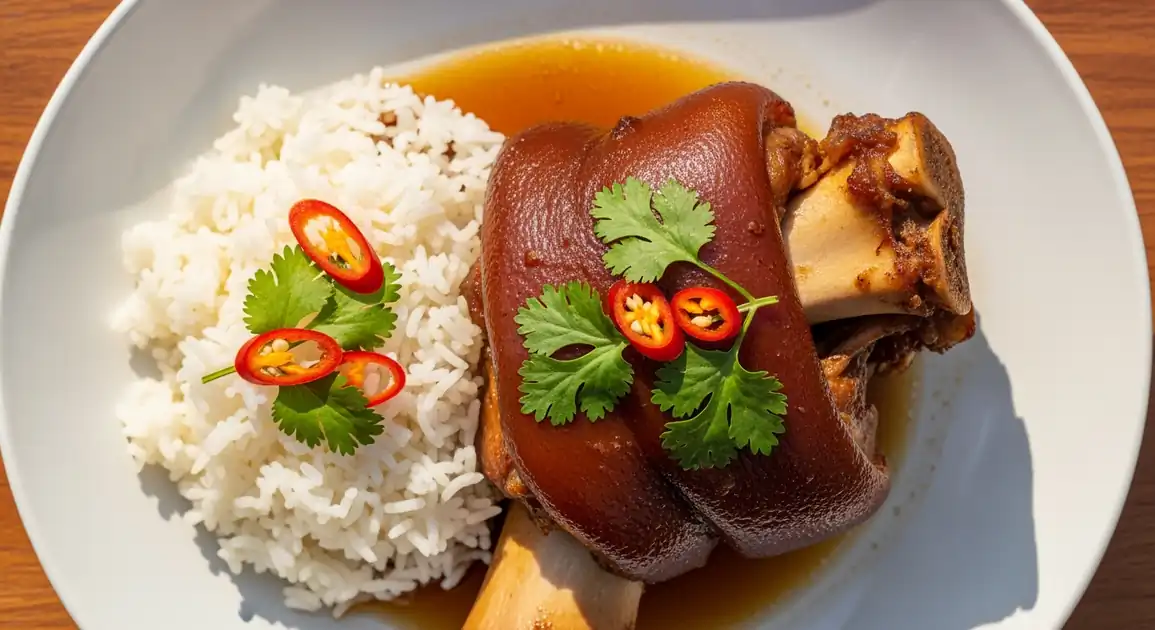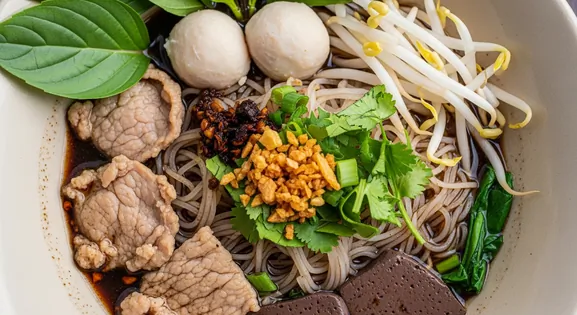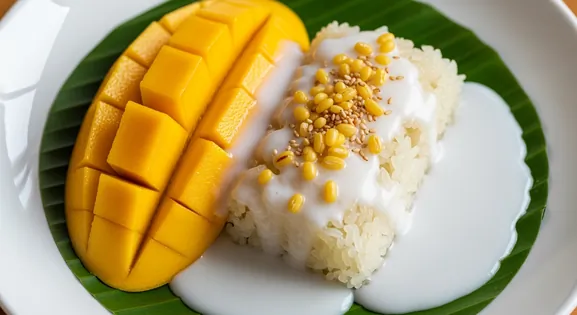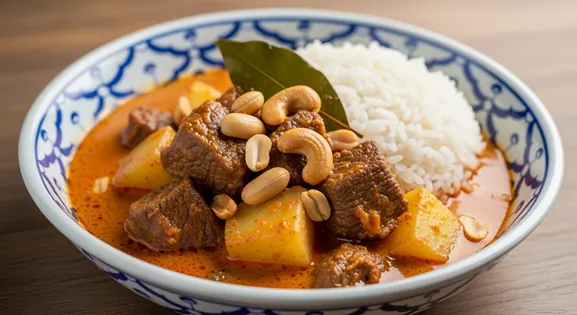Braised Pork Leg in Bangkok
ขาหมูพะโล้ (Kha Moo Palo)

The Essential Guide to Braised Pork Leg
Step into Bangkok's bustling streets and savor Khao Kha Moo, the city's beloved braised pork leg. This rich, tender dish, a testament to Bangkok's Thai-Chinese heritage, offers a comforting, flavorful experience. From humble street stalls to renowned eateries, finding your perfect plate is an essential Bangkok food adventure.
New to Braised Pork Leg? Learn all about its history in our complete guide.
Traditions and Etiquette
Local Significance
In Bangkok, Kha Moo Palo exemplifies the city's diverse culinary heritage, particularly the influential Thai-Chinese fusion that defines much of the capital's food scene.
Eating Customs
- In Bangkok, the dish is often enjoyed with extra condiments including sliced fresh chilies in fish sauce (prik nam pla).
- Locals typically know whether they prefer the 'nam daeng' (lighter, redder broth) or 'nam dam' (darker, more reduced) style.
- Bangkok diners often judge a place first by the quality of its braising liquid rather than the pork itself.
Unique Preparations of Braised Pork Leg
Hongkong Style
Some Bangkok vendors specifically advertise Hong Kong-influenced versions with a stronger five-spice profile and less sweetness.
Muslim-Friendly Duck Version
For non-pork eaters, several Bangkok vendors offer duck leg braised in a similar style, especially around areas with Muslim populations.
Royal Thai Influence
Some upscale Bangkok establishments claim heritage from royal court recipes, featuring more refined seasoning and premium pork cuts.
Modern Fusion
Contemporary Bangkok restaurants sometimes offer creative variations like braised pork leg with wine reduction or Japanese-inspired seasonings.
Pro Tips for an Authentic Experience
Some of Bangkok's most revered Khao Kha Moo vendors, like Charoen Saeng Silom, open early and often sell out by early afternoon. Arrive before noon for the best selection and freshest cuts.
The gelatinous skin (nang) is a prized part of Khao Kha Moo in Bangkok, offering a rich, melt-in-your-mouth texture. Locals often request extra skin for its unique flavor and collagen benefits.
Many long-standing Bangkok stalls maintain a perpetually simmering "nam palo" (braising liquid) pot, often passed down for generations. A dark, bubbling pot indicates a well-established, flavorful broth.
Top Spots for Braised Pork Leg in Bangkok
Yaowarat (Chinatown)
Bangkok's Chinatown hosts some of the most legendary Kha Moo Palo stalls, often family businesses passed down through generations with closely guarded recipes.
Yaowarat Road, Charoen Krung Road, Wat Traimit, Sampeng Market
Lunch, Evening (after 6 PM)
Victory Monument
The area around this major transit hub features several well-known Kha Moo Palo specialists, particularly in the adjoining soi (side streets).
Victory Monument BTS, Rang Nam Alley, Soi Phaya Nak
Lunch, Dinner
Sukhumvit
This long road and its many soi feature vendors catering to both locals and expatriates, with slightly adjusted flavors.
Sukhumvit Soi 38, Thong Lo, On Nut fresh market
Lunch, Dinner
Pratunam
The market area features several long-standing pork leg specialists, often serving shoppers and workers from the garment district.
Pratunam Market, Platinum Mall, Ratchaprarop Road
11 AM - 2 PM, 5 PM - 8 PM
Vendor Tips
- In Bangkok, vendors who display 'Michelin Guide Recommended' or 'Bib Gourmand' stickers generally maintain very high standards.
- Look for vendors with a sign stating 'น้ำซุปต้มสดใหม่ทุกวัน' (fresh broth made daily).
- Bangkok vendors often specialize - some focus exclusively on pork leg rather than offering many dishes, which typically indicates better quality.
An Authenticity Guide
What to Look For
-
Large pot of braising liquid kept at a constant, visible simmer or low boil.
Ensures the pork stays hot and safe. Look for steam and gentle bubbling.
-
Pork leg carved fresh from the whole leg in the pot upon ordering.
Avoid pre-cut piles sitting out. Ensures freshness and proper temperature.
-
Clean chopping block and knife, wiped frequently.
Prevents cross-contamination, crucial as meat is handled after cooking.
-
High turnover, especially in famous areas like Charoen Krung or Yaowarat.
Indicates fresh batches are cooked regularly.
What to avoid
-
Large amounts of pre-cut pork sitting on a tray at room temperature.
High risk of bacterial growth and loss of quality.
-
Braising liquid that looks cool, greasy, or has a thick skin on top.
Indicates insufficient heat, potentially unsafe.
-
Dirty chopping area or vendor handling money and food without washing hands.
Basic hygiene failure.
-
Stalls where the pork looks dry or discolored.
Suggests it might be old or held improperly.
What You Need to Know
Dietary Information
Important Note for Travelers: Your safety is our priority. Below are the common allergens associated with the traditional preparation of this dish. However, recipes and ingredients can vary significantly between establishments. Always confirm all ingredients directly with the food vendor before ordering, especially if you have a severe allergy.
Potential Allergens
Dietary Suitability
Price Guide
Budget Tips
- Chinatown (Yaowarat) vendors offer excellent value at 50-80 THB despite their fame.
- Victory Monument area has several good budget options at 45-70 THB.
- Avoid tourist-heavy areas like Khao San Road where prices can reach 120-150 THB for mediocre quality.
- Food courts in malls like Terminal 21 or MBK offer decent versions for 70-100 THB in air-conditioned comfort.
Serving & Seasonality
Typically served on individual plates with rice, sometimes with a small bowl of clear soup on the side. Street vendors wrap in banana leaf packages or plastic for takeaway. Higher-end establishments might present it more elegantly with careful plating and premium Chinese-style ceramics.Best Times to Enjoy
- Lunch: Most vendors are operating at full capacity, ensuring freshness.
- Dinner: Popular evening option, with some famous vendors operating specifically in evening hours.
- Late Night: Several 24-hour or late-night vendors cater to Bangkok's night owls.
Seasonal Availability
Available year-round with consistent quality.
The Art of Ordering
When ordering Khao Kha Moo in Bangkok, you can specify your preferred cuts: 'nang' (skin), 'neua' (lean meat), or 'kakhi' (trotter). A popular choice is 'pasom' (mixed). Always ask for a braised egg ('kai tom') if available, as it perfectly soaks up the rich sauce. Don't forget to add a spoonful of the spicy 'prik nam som' (chili vinegar) or 'prik nam pla' (chili fish sauce) for an authentic local kick. Some vendors also offer pickled mustard greens ('pak gad dong') on the side.
Practical Guides for Enjoying Braised Pork Leg
Finding Legendary Kha Moo Stalls in Bangkok
Learn how to pinpoint Bangkok's most renowned and long-standing braised pork leg vendors, ensuring an authentic and delicious culinary experience.
- Explore areas like Charoen Krung Road (esp. near Bang Rak), Yaowarat (Chinatown), or Silom (Soi Convent area has a famous stall).
- Look for stalls with 'Khao Kha Moo' (ข้าวขาหมู) signage, often with Thai-Chinese characters.
- Search for specific famous names like 'Charoen Saeng Silom' or stalls recommended in food blogs.
- Expect queues at peak times for renowned vendors.
- Observe the large simmering pots and the vendor's carving technique.
How to Order Khao Kha Moo
Master the art of ordering Khao Kha Moo like a local in Bangkok, from selecting your preferred cuts to adding essential condiments for a perfect meal.
- Approach the stall and specify 'Khao Kha Moo' (rice with pork leg).
- You can often request specific parts: 'Nang' (หนัง - skin/fat), 'Neua' (เนื้อ - lean meat), or 'Kakhi' (คากิ - trotter/foot). A mix ('Pasom' - ผสม) is common.
- Specify if you want a hard-boiled egg ('Kai Tom' - ไข่ต้ม) braised in the same sauce (highly recommended).
- Side dishes like pickled mustard greens ('Pak Gad Dong' - ผักกาดดอง) and fresh garlic/chilies are usually served alongside.
- Confirm the price, typically around 50-80 THB for a standard plate.
Our Commitment to Quality
At Tasteplorers, our mission is to provide the most accurate and useful travel information in the world. To achieve this, all content on this site is created through our unique editorial framework. We utilize leading AI research tools, guided by our proprietary prompts, and a multi-stage validation process. This entire system is overseen by our editorial team to ensure everything we publish meets our high standards for accuracy, cultural nuance, and practical value for travelers.
Learn more about our Editorial Process and our Mission.
Countries
Explore regions
Europe
Discover Europe's diverse culinary landscape, from Mediterranean flavors to hearty Alpine fare. Learn to navigate markets, decode menus, and eat like a local.
Latin America & Caribbean
Discover the vibrant cuisines of Latin America & the Caribbean. Our expert guide covers everything from Mexican street food to Peruvian ceviche and market tips.
Oceania
Explore Oceania's diverse food scene. Learn about Polynesian earth ovens, Fijian feasts, and the vibrant café culture of Australia and New Zealand.
Southeast Asia
Explore Southeast Asia's diverse food cultures from Thailand to Vietnam. Get expert tips on navigating spice levels, choosing quality vendors, and understanding the rich traditions of the region.


